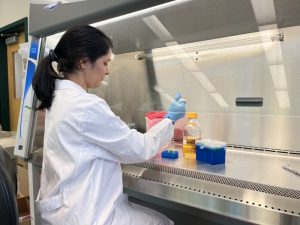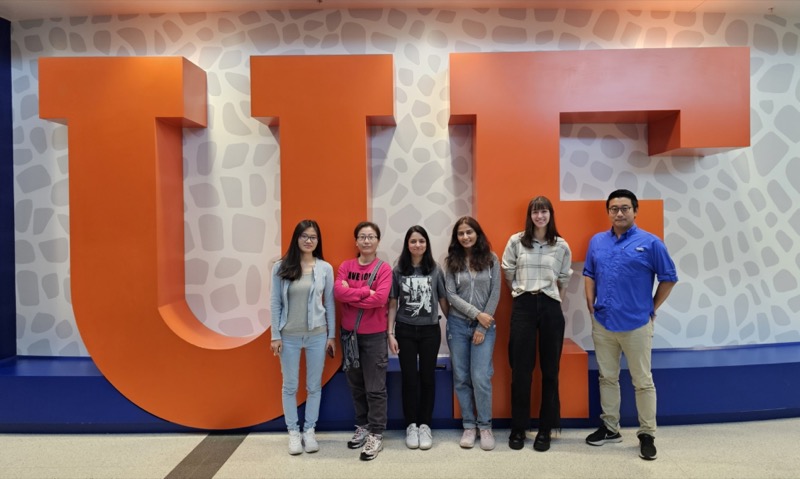 A warm welcome to Sherry Bansal, the latest guest in our FSHN Research Journeys series, which follows graduate students’ research in the Food Science and Human Nutrition program at The University of Florida. Sherry is a food science Ph.D. student studying the effects of nanotechnology in agriculture. With the increased use of nanomaterials in agriculture, it is essential to understand their influence on the agri-food microbiome.
A warm welcome to Sherry Bansal, the latest guest in our FSHN Research Journeys series, which follows graduate students’ research in the Food Science and Human Nutrition program at The University of Florida. Sherry is a food science Ph.D. student studying the effects of nanotechnology in agriculture. With the increased use of nanomaterials in agriculture, it is essential to understand their influence on the agri-food microbiome.
Sherry: In 1959, famous physicist Dr. Richard Feynman gave a lecture titled “There’s plenty of room at the bottom: An invitation to enter a new field of physics”, in which he spoke about exploring science at the nanoscale.1 Since then, nanotechnology has grown by leaps and bounds. Nanotechnology involves engineering materials on a near-atomic scale, creating objects 109 (a billion) times smaller than a meter.2 These nanomaterials exhibit unique properties owing to their size which affects their physical, chemical, and biological conduct, thus enabling us to harness their modified behavior for scientific advancements.2
With so many products made from nanomaterials—such as pharmaceuticals, cosmetics, textiles, electronics, agro-chemicals, and paints—it becomes indispensable to learn about what we create and consume. My graduate research project aims to explore the effects of nanomaterials in agriculture, food, and environmental systems.
Why is the interplay of nanomaterials and microorganisms important to us?

With the increasing problems of food scarcity, food waste, and climate change, global agricultural and food production demands are soaring.3,4 Microorganisms can help appease this amplified agricultural pressure.5 They play an integral role in agri-food systems, such as induction of nutrient cycling in soil, nitrogen fixation, food fermentations, and even serving as alternate food sources.6,7 For these reasons, evaluating and addressing safety concerns of the agri-food microbiome becomes imperative.
The past decades have witnessed an increase in the use of nanomaterials in different disciplines, including agriculture. For example, nano-formulated agrochemicals such as fertilizers, pesticides, insecticides, plant growth stimulators, and seed primers are used in agriculture.6 However, the effects of these nanomaterials on microbial evolution and prokaryotic cells remain relatively uninvestigated. Analyses of nanomaterials have indicated their migration and prolonged persistence in agri-food systems, which can have unforeseen consequences for the microbiome.8

The agricultural nanomaterials influencing our food and fodder crops affect the linked microbiota. Beyond their intended use, nanomaterials can lead to outcomes, like increased metabolic stress on microbes and reduced efficiency in participating in processes important for soil health.8,9 This evaluation of nanomaterials in agri-food microbiomes becomes even more important, especially in the wake of problems such as growing food safety concerns, ever-rising foodborne illnesses, anti-microbial resistance, and climate change.10
Through my research project, I’ll seek answers to several questions, including if and how the nanomaterials in our agricultural environment affect pathogen evolution, microbial physiology, and their adaption. I will evaluate nanomaterials’ long- and short-term effects on microbes and how they affect food safety and pathogen persistence. In addition, I will explore the impact of climate change on the interaction of microorganisms and nanomaterials and their subsequent retention in the microbiome.
Embracing the gator spirit
My master’s degree project at The Ohio State University focused on developing a rapid foodborne pathogen detection method using nuclear resonance-based metabolomics. During this journey, it was disheartening to realize that neglecting food safety not only aggravated hunger problems but also held the potential to claim the lives of people trying to relish a purportedly nutritious meal. With the hope of assuaging the problem, I wanted to continue working in food safety and microbiology.
While exploring different research avenues in food safety, I found Dr. Boce Zhang’s research on food microbiology very exciting and compelling. Becoming part of such a dynamic team at the University of Florida allowed me to enhance my skills through engagement with cutting-edge technologies while learning more about food microbiology. The nanomaterial safety assessment research project addresses an important knowledge gap in food safety. The multi-disciplinary nature of this study combines the subjects of climate change and anti-microbial resistance as well as food safety and security to address the effects of advancing fields like nanotechnology. This research project provides compelling ground to participate in a study directed toward contributions for a better future.

Evaluating the fate of microbes after their interaction with nanomaterials
To understand the implications of the nanomaterials used in agri-food systems on food and agricultural microbiomes, we plan on synthesizing selected nanomaterials commonly used in agri-food systems. These nanomaterials include carbon, metallic, polymeric, and complex nanomaterials. We will look at their physiochemical aspects such as size, shape, surface properties, and composition using different spectroscopic techniques and electron microscopy.
The next step will be seeing how these nanomaterials affect the microbes in soil and irrigation water samples. This step will include mimicking climate change (up to the year 2100 per NASA predictions) using climate-controlled equipment and analyzing the interactions between microbes and nanomaterials. Machine learning analysis will be performed to observe any patterns in the interactions. Lastly, we wish to understand how the microbes in the samples and their next generations evolve and adapt to the nanomaterials in the samples. This evolution will be evaluated by examining the microbial genetic material and its metabolites.

The results from this research will guide the safe usage of the tested nanomaterials. For example, the results of my study may suggest detrimental effects of nanomaterials, such as increased anti-microbial resistance. This resistance can reach humans via food and penetrate the food chain and environment leading to health concerns, lower crop yield, reduced food safety, and economic losses.11,12 In such a case, nanomaterials’ handling, usage, dosage, or targeted delivery design could be altered or restricted. Alternatively, if specific nanomaterials are known to possess beneficiary effects, such as enhanced symbiotic relations in soil or improved microbial metabolism, those outcomes could be explored, and the corresponding nanomaterials could be harnessed for further applications.13
Towards a better and safer tomorrow
Since the cost of operating these studies could be high, assessment of all possible nanomaterials might be difficult to cover. We will study a selected number of nanomaterials depending on their usage frequency in agricultural applications. Sample types, microbes, and environmental conditions might also impose time and design constraints for weighing in all the possible scenarios for each interaction as in the real world.
Despite these obstacles, understanding the effect of nanomaterials on microorganisms in agri-food systems will eventually guide our comprehension of different microbiome-nanomaterial interactions, thus helping us make informed choices for the times ahead.
Sherry Bansal was born and raised in Punjab, India. She is a Ph.D. food science student in Dr. Boce Zhang’s UF/IFAS’s FSHN department lab. She completed her MS in food science from The Ohio State University and her BTech in food technology from Punjab Agricultural University. In her free time, Sherry loves reconnecting with her favorite recreational activity of exploring, practicing, and admiring different types of arts.
References
- Feynman, R. P. There’s plenty of room at the bottom. Engineering and Science 23, 22–36 (1960).
- Nanotechnology | NIOSH | CDC. https://www.cdc.gov/niosh/topics/nanotech/default.html (2023).
- FAO. The future of food and agriculture—Trends and challenges. Rome. (2017).
- FAO. The future of food and agriculture – Drivers and triggers for transformation. Rome. (2022). doi:10.4060/cc0959en.
- Macdonald, C. & Singh, B. Harnessing plant-microbe interactions for enhancing farm productivity. Bioengineered 5, 5–9 (2014).
- Jurburg, S. D. et al. Potential of microbiome-based solutions for agrifood systems. Nature Food 3, 557–560 (2022).
- Singh, B. K., Trivedi, P., Egidi, E., Macdonald, C. A. & Delgado-Baquerizo, M. Crop microbiome and sustainable agriculture. Nature Reviews Microbiology 18, 601–602 (2020).
- Mitrano, D. M., Motellier, S., Clavaguera, S. & Nowack, B. Review of nanomaterial aging and transformations through the life cycle of nano-enhanced products. Environment International 77, 132–147 (2015).
- da Silva Júnior, A. H., Mulinari, J., de Oliveira, P. V., de Oliveira, C. R. S. & Reichert Júnior, F. W. Impacts of metallic nanoparticles application on the agricultural soils microbiota. Journal of Hazardous Materials Advances 7, 100103 (2022).
- Chai, H. et al. The effect of metal oxide nanoparticles on functional bacteria and metabolic profiles in agricultural soil. Bulletin of Environmental Contamination and Toxicology 94, 490–495 (2015).
- Hudson, J. A. et al. The agri-food chain and antimicrobial resistance: A review. Trends in Food Science & Technology 69, 131–147 (2017).
- George, A. Antimicrobial resistance, trade, food safety and security. One Health 5, 6–8 (2017).
- Karimi, E. & Mohseni Fard, E. Nanomaterial effects on soil microorganisms. in Nanoscience and Plant–Soil Systems (eds. Ghorbanpour, M., Manika, K. & Varma, A.) 137–200 (Springer International Publishing, 2017). doi:10.1007/978-3-319-46835-8_5.
Looking for more posts exploring graduate research projects in the FSHN Department at the University of Florida?
Dive into the Research Journeys of other graduate students below.
M.S. Food Science
M.S. Nutritional Sciences
Ph.D. Food Science
Ph.D. Nutritional Sciences
 1
1
